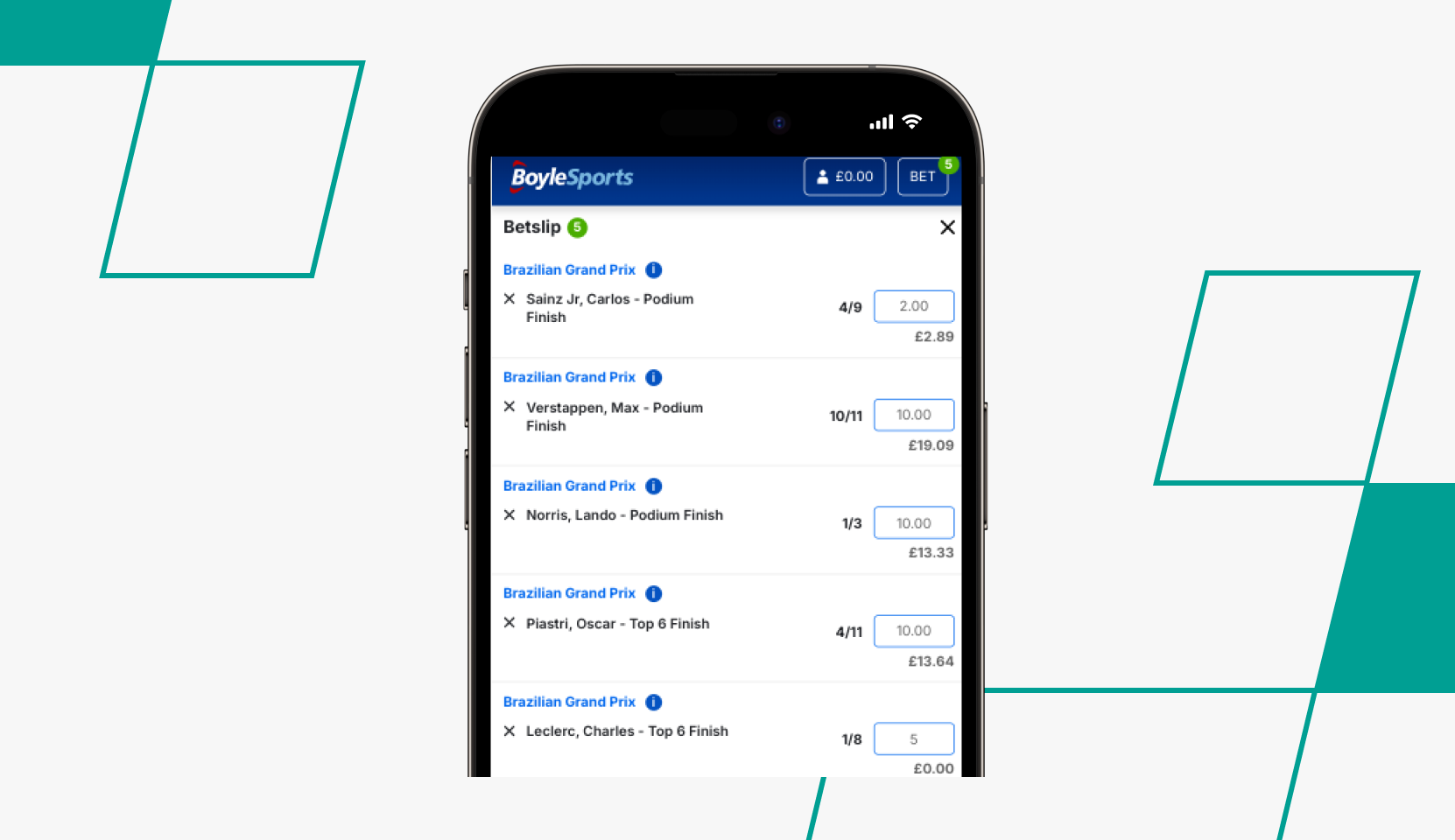F1 betting offers punters an average of 50 exciting markets to explore for every Grand Prix, adding even more thrill to that high-octane action. Our guide highlights the best F1 betting sites, where you can find competitive odds, the latest F1 tips, predictions, and more.
- 1 Best Betting Sites for Formula 1
- 2 Top 10 Formula 1 Betting Sites Reviewed & Ranked
- 3 How We Ranked F1 Bookmakers
- 4 How To Place a Bet on Formula 1 Races — Step-by-Step Guide
- 5 Formula 1 Betting Markets
- 6 The Best Formula 1 Betting Apps
- 7 F1 Betting Tips — How To Get the Most Out of Your F1 Bets
- 8 F1 2024 Predictions — Best Advice for Punters
- 9 Formula 1 Betting Promotions & Offers 2025
- 10 Do UK Betting Sites Offer F1 Livestreaming?
- 11 Formula 1 2025 Schedule
- 12 Formula One Key Stats To Consider When Betting
- 13 F1 Regulation Changes in 2024 That Affect Betting
- 14 ThePuntersPage Final Say
- 15 Formula 1 Betting FAQs
Best Betting Sites for Formula 1
|
Founded:
1994
UK Gambling Commission
This bookmaker is licensed by the UK Gambling Commission (UKGC), ensuring compliance with strict regulations designed to promote fairness, transparency, and the safety of players. The UKGC license is a mark of trust, safeguarding your funds and personal information while encouraging responsible gambling. Learn more about the UKGC here
Payment methods(4):
Bet £10 & Get £30 in Bonuses 18+New Customers Only. Opt in and bet £10 on football (odds 2.00+) within 7 days. No cash-out. Get 4x£5 Free Bets for set markets and a £10 Slot Bonus for Big Bass Splash, 30x wagering, to withdraw max £250. Rewards expire in 20 days. Full T&Cs apply. Bet Responsibly. GambleAware.org #ad |
|
Founded:
2000
UK Gambling Commission
This bookmaker is licensed by the UK Gambling Commission (UKGC), ensuring compliance with strict regulations designed to promote fairness, transparency, and the safety of players. The UKGC license is a mark of trust, safeguarding your funds and personal information while encouraging responsible gambling. Learn more about the UKGC here
Payment methods(11):
Bet £10 & Get £30 18+. Min deposit requirement. Free Bets are paid as Bet Credits and are available for use upon settlement of qualifying bets. Min odds, bet and payment method exclusions apply. Returns exclude Bet Credits stake. Time limits and Full T&Cs apply. Bet Responsibly. GambleAware.org #ad |
|
Founded:
1946
UK Gambling Commission
This bookmaker is licensed by the UK Gambling Commission (UKGC), ensuring compliance with strict regulations designed to promote fairness, transparency, and the safety of players. The UKGC license is a mark of trust, safeguarding your funds and personal information while encouraging responsible gambling. Learn more about the UKGC here
Payment methods(6):
Bet £10 & Get £30 in Football Free Bets 18+ New customers only. Opt in, bet £10 or more on any football market at minimum 1/1 odds within 7 days of registration. No cash out. Get £30 in Free Football Bets, selected markets. Free Bets expire in 7 days. Full T&Cs apply. Please gamble responsibly. GambleAware.org #ad |
|
Founded:
1926
UK Gambling Commission
This bookmaker is licensed by the UK Gambling Commission (UKGC), ensuring compliance with strict regulations designed to promote fairness, transparency, and the safety of players. The UKGC license is a mark of trust, safeguarding your funds and personal information while encouraging responsible gambling. Learn more about the UKGC here
Payment methods(8):
Bet £5 Get £20 18+ New Customers only. Certain deposit methods & bet types excl. Min first £/€5 bet within 14 days of account reg at min odds 1/2 to get 4 x £5 free bets. Free bet available to use on selected sportsbook markets only. Free bets valid for 7 days, stake not returned. Restrictions + Full T&Cs apply. Bet Responsibly. GambleAware.org #ad |
|
Founded:
1886
UK Gambling Commission
This bookmaker is licensed by the UK Gambling Commission (UKGC), ensuring compliance with strict regulations designed to promote fairness, transparency, and the safety of players. The UKGC license is a mark of trust, safeguarding your funds and personal information while encouraging responsible gambling. Learn more about the UKGC here
Payment methods(9):
Bet £5 Get £20 in Free Bets 18+ New UK+IRE Customers only. Certain deposit methods & bet types excl. Min first 5 bet within 14 days of account reg at min odds 1/2 = 4x 5 free bets. Free bets valid for 7 days, stake not returned. No cashout, restrictions + Full T&Cs apply. Bet Responsibly. GambleAware.org #ad |
|
Founded:
1923
UK Gambling Commission
This bookmaker is licensed by the UK Gambling Commission (UKGC), ensuring compliance with strict regulations designed to promote fairness, transparency, and the safety of players. The UKGC license is a mark of trust, safeguarding your funds and personal information while encouraging responsible gambling. Learn more about the UKGC here
Payment methods(3):
Bet £10 Get £10 in Free Bets 18+, UK only. Deposit and place a £10 cash bet at single or accumulated odds of 1/2 (1.5) or greater and we will give you £10 in free bets. Free bets credited as 2 x £5 bets. 1x Football, 1x Racing. Void or 'Draw No Bet' wagers do not qualify for this promotion. Available once per customer. Free bets will be credited at bet settlement and will expire 7 days after being credited. Full T&C's apply. Bet Responsibly. GambleAware.org #ad |
|
Founded:
2003
UK Gambling Commission
This bookmaker is licensed by the UK Gambling Commission (UKGC), ensuring compliance with strict regulations designed to promote fairness, transparency, and the safety of players. The UKGC license is a mark of trust, safeguarding your funds and personal information while encouraging responsible gambling. Learn more about the UKGC here
Payment methods(10):
100% up to £50 Welcome Bonus 18+ New bettors; Code SPORT; Wager deposit & bonus 8x; Max qualifying bet stake=initial bonus; Valid 60 days; Min odds, bet and payment method exclusions apply; Full T&Cs apply. Bet Responsibly. GambleAware.org #ad |
|
Founded:
1999
UK Gambling Commission
This bookmaker is licensed by the UK Gambling Commission (UKGC), ensuring compliance with strict regulations designed to promote fairness, transparency, and the safety of players. The UKGC license is a mark of trust, safeguarding your funds and personal information while encouraging responsible gambling. Learn more about the UKGC here
Payment methods(6):
Bet £10, Get up to £60 in Free Bets 18+ Spread betting losses can exceed deposit. 18+ www.gambleaware.org. Place a £10 fixed odds single or £10 each-way bet at minimum odds of 1/2 and get 3 x £10 free fixed odds bets, 3 x £5 Total Goals football spread bets and 3 x £5 Winning Favourites spread bets and a £1 racing Race Index spread bet. Full T&Cs apply. Bet Responsibly. GambleAware.org #ad |
|
Founded:
1967
UK Gambling Commission
This bookmaker is licensed by the UK Gambling Commission (UKGC), ensuring compliance with strict regulations designed to promote fairness, transparency, and the safety of players. The UKGC license is a mark of trust, safeguarding your funds and personal information while encouraging responsible gambling. Learn more about the UKGC here
Payment methods(7):
Bet £10 Get £50 in Free Bets 18+ New customers only. Register with BETFRED50. Deposit £10+ via Debit Card and place first bet £10+ at Evens (2.0)+ on Sports within 7 days to get 3 x £10 in Sports Free Bets & 2 x £10 in Acca Free Bets within 10 hours of settlement. 7-day expiry. Eligibility & payment exclusions apply. Full T&Cs apply. Bet Responsibly. GambleAware.org #ad |
|
Founded:
2015
UK Gambling Commission
This bookmaker is licensed by the UK Gambling Commission (UKGC), ensuring compliance with strict regulations designed to promote fairness, transparency, and the safety of players. The UKGC license is a mark of trust, safeguarding your funds and personal information while encouraging responsible gambling. Learn more about the UKGC here
Payment methods(9):
Bet £10 and Get £30 in Free Bets 18+ New selected customers only. Qualifying bet of £10 at min. odds 2.0 within 5 days of registration, E/W excluded. Get 3 x Free Bets: 1 x £10 Football, 1 x £10 Racing, 1 x £10 Acca (Min 4 selections). 7-day expiry. Min. deposit of £10. Full T&Cs apply. Bet Responsibly. GambleAware.org #ad |
|
|
Top 10 Formula 1 Betting Sites Reviewed & Ranked
The following bookmaker reviews cover those F1 betting sites that provide extensive offerings for all Grand Prix events, competitive odds, and plenty of features to enhance your F1 betting experience. Let’s check them out below.
Parimatch UK — Special Grand Prix Race Lucky Dips
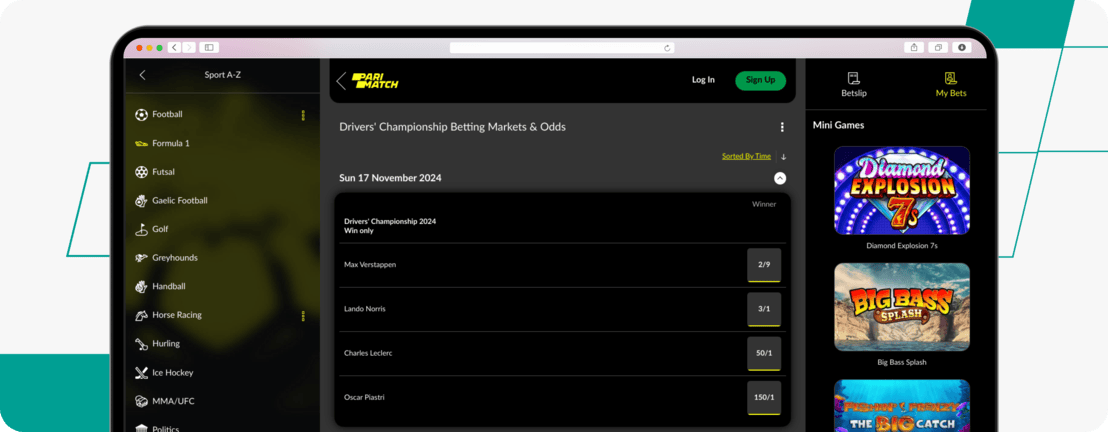
The usual array of F1 bets found on Parimatch covers markets for drivers and teams, including podium/points and retirements.
Parimatch offers two unique Lucky Dips for F1 betting with incredibly generous prices for certain markets. You can take a random punt on each Grand Prix race by entering your stake and spinning the wheel to receive your random odds and increase the payout potential. Pretty neat, right?
Here's a sneak peek. You can go for the race winner at odds of 16/1 and/or opt for the straight forecast of correctly naming the first and second drivers at a whopping 330/1. Each Lucky Dip has a maximum stake per spin, but there are no limits on the number of spins.
- In-play betting for Grand Prix race
- Trending bets for Formula One
- A vast array of F1 markets
- Limited payment options
- Mini games details on the right-hand side clutter up the page
bet365 — Offers Detailed Live Race Graphics
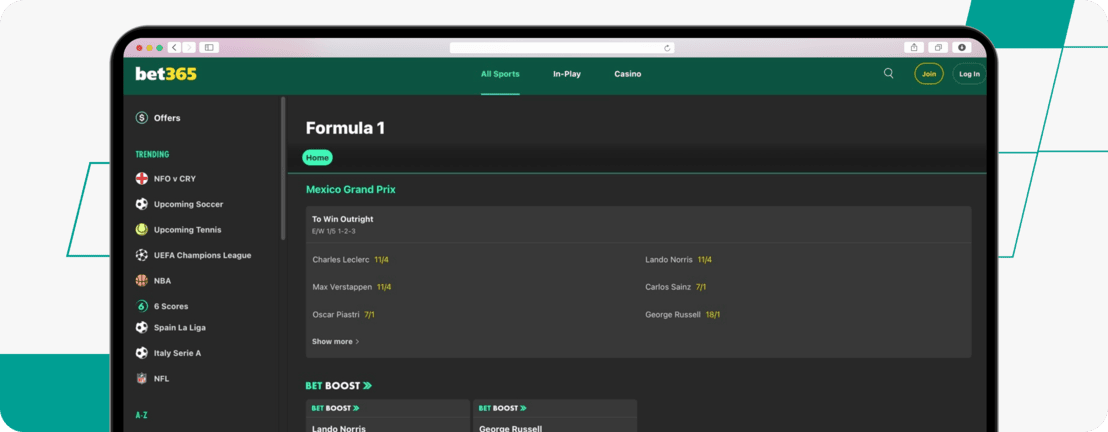
bet365 provides a colossal selection of F1 markets, including qualifying outrights and combos – all of which come at highly competitive odds, no matter the Grand Prix race.
With live betting on F1, the bookie breaks the mould. bet365 is speedy in updating the odds for outrights following the qualifications, so you’ve got to react quickly and capitalise on the odds shifts.
Ultimately, the bookie’s comprehensive coverage, which includes a news section, race preview, and team stats, makes it one of the top F1 betting sites out there. You can always rely on their live track graphics and stats during each GP race when betting on races in progress.
- F1 news and interviews, including betting tips from the bet365 news team
- 20+ Formula One markets for every Grand Prix
- Welcome offer can be used for F1
- Odds only appear close to each Grand Prix
- Slow registration approval
BetVictor — Free F1 Bets With Loyalty Club
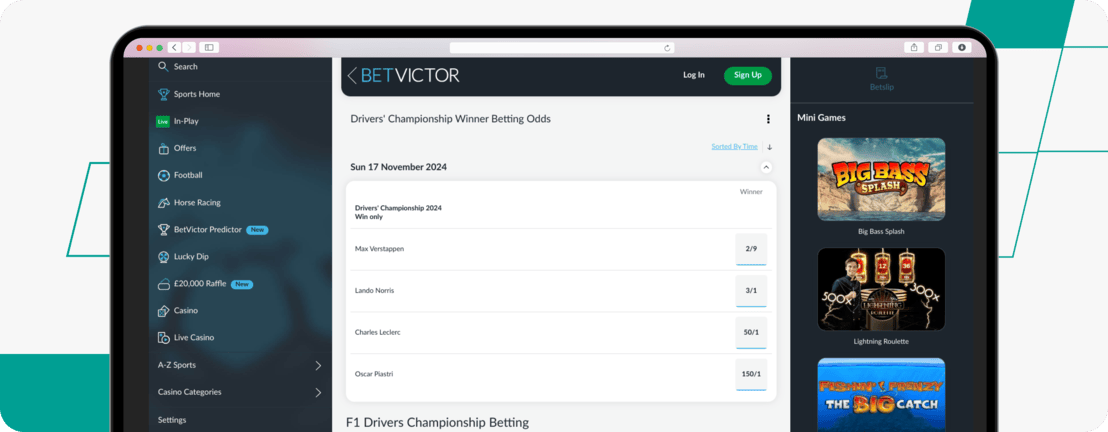
BetVictor delivers in-depth coverage for each Grand Prix weekend, with excellent opportunities for race position and podium finish betting, as well as head-to-head wagers between drivers.
The BetVictor Loyalty Club ensures all customers get some freebies for F1 betting. There’s the opportunity to claim a free bet worth between £1 and £25 for wagering on all F1 events. To receive a virtual box containing your free bet, you must opt in and place five wagers of £5 or more weekly (Monday to Sunday) on any sport, including motorsports.
Alternatively, you may wish to take advantage of the Bet Boosts available for the main race, with increases that mainly cover outright markets.
- Bet Boosts for Formula One
- Covers wide variety of F1 markets
- Lower overround Grand Prix odds
- Most promotions are focused on new players
- Odds for top drivers can be low until the Grand Prix weekend starts
Coral — Exclusive Bonuses & Promos for F1

Over any Grand Prix weekend, Coral puts F1 betting first. All F1 markets are found under the tabs that read today, tomorrow, and future, allowing simple navigation.
The markets are categorised into qualifying for the next grand prix, the race itself, and the overall championship, so all you need is a couple of clicks or taps on the screen to get all the odds.
In addition to an impressive range of diverse betting markets throughout the season, you can ask for specific F1 multiple bet odds using the #YourCall feature via X (formerly Twitter).
Coral always offers enhanced prices for Grands Prix; for example, the Super Boosts special deal adds value for all existing customers. On average, the odds increase between 10% and 15% when boosted.
- Excellent range of F1 markets
- Rapid withdrawal times
- Welcome offer can be used for Formula One betting
- Could offer more payment options
- No VIP programme
Ladbrokes — Comprehensive Formula One Coverage
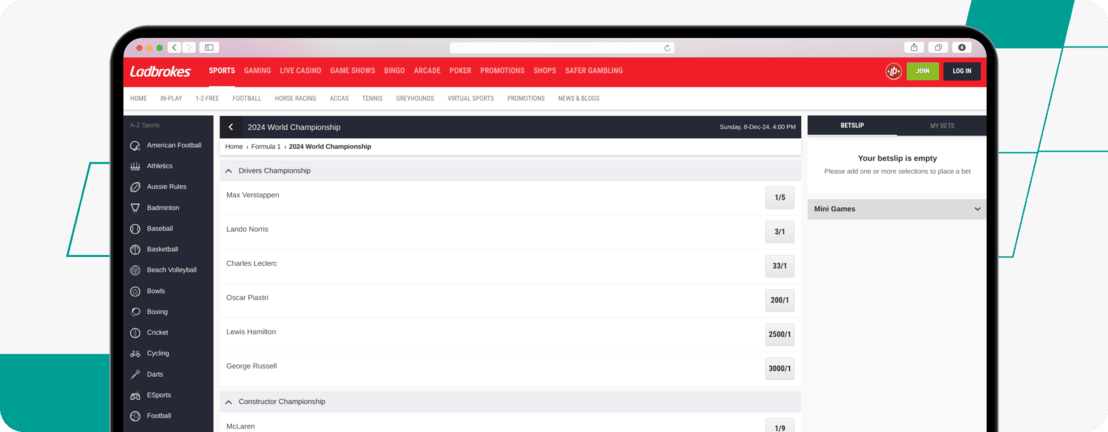
Ladbrokes consistently delivers competitive odds on outrights and race specials throughout the season. There are extensive betting markets that include the nationality of the F1 Grand Prix winner, the winning margin, car and driver retirements.
The convenience of the Ladbrokes Grid card allows UK customers to instantly claim their winnings in cash at any high-street shop rather than online.
The bookie delivers top-notch coverage of F1 with a news site — brimming with in-depth race details, including betting tips, predictions, data and stats — that encourages both in-play and outright betting.
- Instant withdrawals with Ladbrokes Grid card online
- Ladbrokes Odds Boost for ante-post F1 Grand Prix betting
- Regular features on Facebook and X (formerly Twitter)
- App appears slightly cluttered when looking at markets and prices
- Withdrawals, apart from the Ladbrokes Grid Card service, could be faster
The Pools — Free F1 Bets With Loyalty Programme
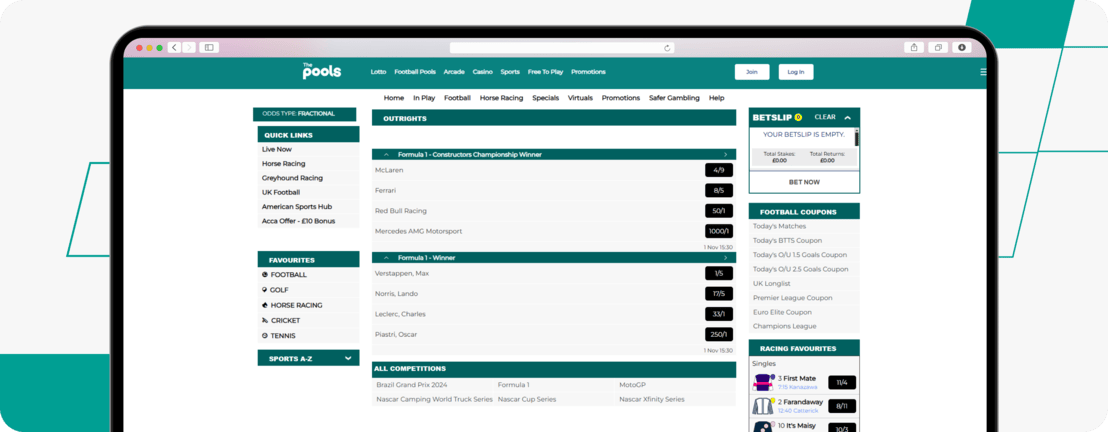
The Pools does everything well, without the bells and whistles of rival F1 betting sites. Bettors can exploit a creditable set of solid F1 betting options and markets, such as season-long head-to-head showdowns between drivers and teams.
The Pools has both a bet builder with their “Create a Bet” feature and a cash-out option that’s good for F1 racing. As a solid all-rounder for Formula One, you will find competitive odds, live betting, and strong markets, as well as impressive season-long coverage for the F1 world championships.
Their standout feature is their Loyalty Club, which offers players a £5 free bet every time they place ten bets (at odds greater than or equal to evens) of £5 or more on any event.
- Attractive F1 prices
- Bet boosts available for Formula One markets
- Superb Grands Prix coverage
- Customer service is not 24/7
- Debit card payment only
10bet — Up to 100% Boost F1 ACCA
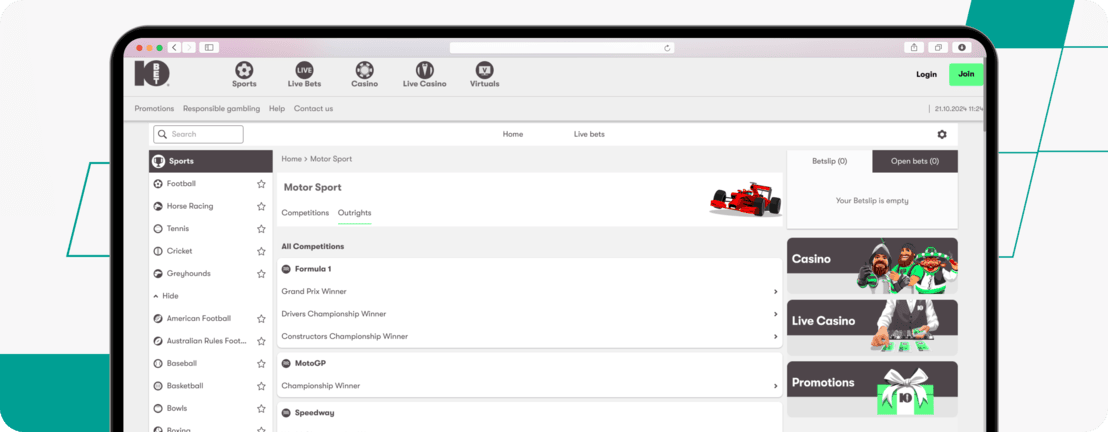
With Formula One found under their motor racing section, 10bet provides more than 20 markets with excellent live online odds and fast settlement for live bets.
However, where 10bet shines the most is when you look at its impressive set of race match bets between two drivers at each Grand Prix, on top of strong bet builder and cash-out features.
If you fancy an ACCA, you can get up to 100% boost on a minimum of three selections for F1 with 10bet.
- Dynamic in-play F1 odds
- Solid set of Formula One markets
- Rapid payouts
- Lacks ACCA insurance
- Live chat can be slow
SpreadEx — Unique F1 Spread Betting

SpreadEx is focused on spread betting, with F1 punters able to have an exceptional flutter on index spread, matchbet, and numbers markets. There are plenty of pre-race, live, and outrights options among the vast array of F1 betting markets, including the most popular punts with attractive odds. SpreadEx also delivers fixed odds on Formula One.
The F1 index spreads encompass the Constructors' Championship and Drivers’ Championship for long-term spread bets, qualifying, the Grand Prix race, and an in-play index spread during the race.
SpreadEx’s F1 match bets pit two drivers against each other. There are also opportunities for a wager on the Race Winner’s Number, aggregate Podium Car Numbers, and the Number of Classified Finishers.
- Excellent customer service
- Fantastic for F1 spread betting
- Terrific for withdrawals
- No current F1 promotions
- Inherent risk of spread betting
Betfred — Offers the Most Detailed F1 Stats

On Betfred, you can find the latest odds and markets listed under the Formula 1 section, with the initial choices of sprint events, qualifying, the GP race, and more.
The bookie delivers customisation with the option of their innovative #PickYourPunt Bet Builder feature. You can propose bespoke bets via X (formerly Twitter) and the operator will respond with tailored odds.
Betfred will appeal to F1 bettors who savour stats and analysis, as the operator boasts extensive coverage with realms of data and winning trends. The bookie also boasts an Insights Page, which provides F1 betting tips for the Grands Prix and customisable bets.
- Brilliant for F1-applicable promos
- #PickYourPunt Bet Builder
- Rich array of F1 betting markets
- The bonus amount could be better
- Lacks consistent withdrawal time frames
Kwiff — Supercharged Odds Once Bets Get Placed
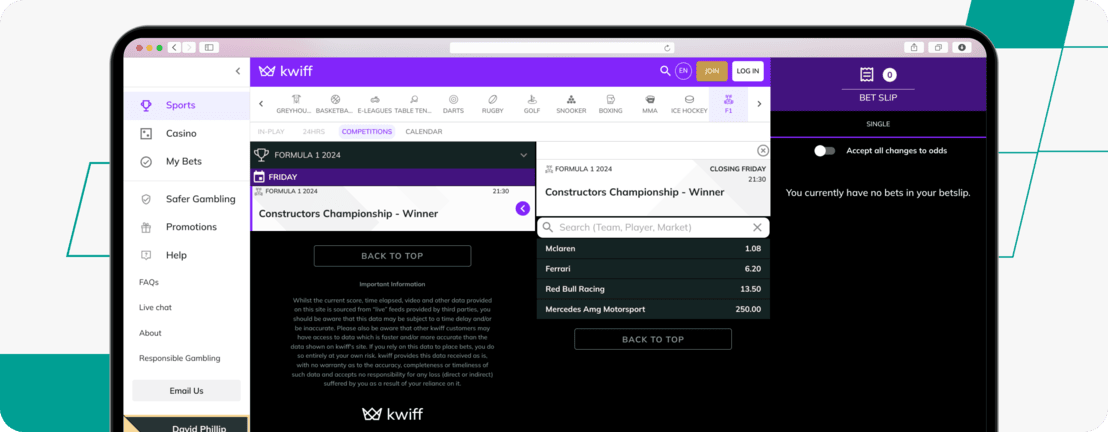
Kwiff offers their unique boost to your F1 odds, randomly enhanced and referred to as supercharged “Kwiffs”. However, there is a drawback with these Kwiffs. You won't know if you've been offered a bigger payout until you've placed your bet.
Their Formula One markets are more limited than their main competitors like bet365 or Parimatch, as they only offer the most popular betting opportunities. Yet Kwiff provides excellent GP race graphics and will fully refund your punt if your selected race driver fails to cross the finishing line.
- Good promos and loyalty club
- Great selection of Formula One markets
- Unique supercharged “Kwiffed” F1 odds
- Limited banking options
- Withdrawals are not instant
How We Ranked F1 Bookmakers
Attractive prices can rapidly swing during the long GP weekend, which is great for punters who enjoy in-play betting. Our preferred operators are those that are quick to react to the action on the track by constantly updating their betting odds. We only recommend bookies which offer an impressive range of F1 markets with specials.
We steer you towards F1 betting sites that provide a free bet sign-up offer to boost your initial bankroll. Attracting new customers through this deal helps bring F1 fans closer to the action, as you can study form and more before staking a wager.
Each online sportsbook is unique, although only the ones that deliver impressive F1 features have qualified for our list of recommended bookmakers. Live graphics for the F1 race are one of the most prominent features around, alongside bet builders and cash-out betting options.
There can be red flags when seeking a bookie that accepts your favoured currency and payment methods for Formula 1 bets. We have sourced operators who offer transactions that range from traditional debit cards and bank transfers to e-wallets.
Gambling is exciting if you approach it in a sensible manner, such as placing informed bets and setting a budget to play with each month. Together with our operators, we are strong advocates of responsible gambling.
Our preferred online sportsbooks will always provide you with a ton of security while you are having a flutter on F1. We only list bookies with biometric login options, SSL encryption, and unbreachable firewalls that ensure your data and transactions are safe at all times.
How To Place a Bet on Formula 1 Races — Step-by-Step Guide
There are dozens of ways to bet on Formula 1, with popular wagers including outright winner and a top six finish. We’ve prepared an expert step-by-step guide on how to place an F1 bet using BoyleSports below:
Formula 1 Betting Markets
Placing a wager on the winning driver and/or team at a Grand Prix is the ultimate betting market. However, there are more generous prices available if you select other F1 markets, such as the race specials. Let’s take a closer look at them.
A bet that comprises two or more selections in one bet, some bookies have a minimum of three selections. All of the selections must win to guarantee a return on your stake.
A wager after the F1 betting market has opened, with favourable odds in comparison to waiting nearer to the Grand Prix race.
This is an Under/Over stake, where you predict the exact number of finishers at a Grand Prix.
A bet on the team to be crowned the Constructors’ Championship winner at the end of the season.
Some online sportsbooks offer odds on F1 driver pairings, which means that you get two picks for the price of one.
A bet on the team to be crowned the Constructors’ Championship winner at the end of the season.
A wager where you choose two drivers prior to a Grand Prix race. To win, you need them to finish first and second, but in no particular order.
Backing a driver to record the quickest lap in either practice, qualifying, the Sprint race, or the Grand Prix race.
A bet on the driver who registers the shortest total time in one pit stop during a Grand Prix race.
A flutter on a driver to make or miss the cut to qualify for the Grand Prix race.
This is when you can take advantage of the free bets and incentives offered by a bookie who will match your wager.
A bet on a head-to-head contest between two F1 drivers of similar odds that have been matched up by a bookmaker.
A flutter on whether the total will add up to more or less than the projected number set by bookies. For markets like the total number of cars to finish the GP race and the winning margin between first and second place.
A wager on your preferred player to finish on the final leaderboard in a certain position. Many bookmakers offer Top 6 and Top 10 places.
When you pick a winner but have accepted reduced odds as you are hedging your bets. You get your stake back if the player finishes runner-up (or with some operators, a driver need only achieve a Top 5 finish).
A bet on a driver to finish in the top 3 places at a Grand Prix race and finish on the podium.
A stake on a driver to complete a Grand Prix race with points allocated, which means they have to finish in the top 10.
When you back the driver who wins qualifying and secures first place, referred to as pole position, on the starting grid for a Grand Prix race.
A wager on the winning driver at each Grand Prix practice session. Numerous bookmakers offer multiple bets for the fastest drivers in each practice 1 and practice 2 session. You can back the same driver or different ones.
A bet on the winning team for each practice session at a Grand Prix. Some bookies have multiple bets for the fastest teams in each practice 1 and practice 2 session. You can back the same team or different ones.
A stake on who takes the chequered flag to finish first in a Grand Prix race.
A simple yes or no flutter on whether a physical (rather than virtual) safety car enters the track at any point during a Grand Prix race.
Single or multiple bets specific to a certain F1 driver and/or team, usually with highly attractive odds.
A flutter on the fastest overall driver in the 100km Sprint race. Points are awarded to the top eight drivers.
A bet on the F1 team that wins the Sprint race, a dynamic dash event that lasts around half an hour. Teams compete to try and finish in the top eight positions to win points.
When you predict the finishing order of two drivers in first place and runner-up in a Grand Prix race.
A wager on which F1 team will end the Grand Prix weekend with the most points. Sprint races are limited each season and not at each GP meeting.
A bet on the F1 team to finish first at a Grand Prix.
A stake on the nation of the F1 driver who is first over the finish line at a Grand Prix.
The Best Formula 1 Betting Apps
With so many betting apps available for F1 betting, we have done the groundwork to highlight our three favourite bookies for having a punt on the action from the iconic racing circuits.
bet365 (4.6 App Store Rating/ 4.5 Google Play Rating)
The bet365 betting app offers the same functionality as its desktop counterpart. For instance, there’s an extensive news section with the latest F1 circuit bulletin. Plus, there are no glitches and freezes when you switch between sections of the app, so you can count on its stability when betting on F1 races live.
Parimatch (4.4 App Store Rating/ 4.5 Google Play Rating)
Navigation on the Parimatch betting app is a breeze thanks to their main menu. It includes shortcuts such as live bets at the base of the screen, which makes placing rapid in-play wagers easier. With F1 live odds updated during practice, qualifying, and the main race, this app allows you to follow the action closely and make an informed wager.
BetVictor (3.2 App Store Rating/Google PlayStore Rating)
The BetVictor app is similar to its desktop counterpart in functionality, offering cash-out and other promotions that can be used on F1 wagering. This app is excellent if you are on the move and don’t want to miss the circuit action, as you can follow GP action with BetVictor’s live graphics, and use in-play betting during the main race.
F1 Betting Tips — How To Get the Most Out of Your F1 Bets
Want to learn how to bet on Formula 1? You first need to understand the tools at your disposal. Add to that, you will need a solid understanding of the sport that goes beyond casual viewership. With the right knowledge, you should be able to identify value bets and even predict race outcomes with reasonable accuracy.
Below are some Formula 1 betting tips to get you started as a serious punter:
Use F1 Stats
The official F1 website will also give you a ton of other news and information, which you can use to augment your data-based strategy.
Find Value with F1 bets
When Formula 1 betting, it is vital to seek the best value with your wagers. Sometimes betting on the favourite at a short price is unlikely to give you much back on your stake. Instead, scour around and place a punt on drivers that are either undervalued or underestimated, as you can score bigger wins at longer odds.
Know Your Engines
Each Formula 1 car performs differently in different circumstances – just as a driver can perform differently on different tracks. Get to know how your car of choice performs on straight tracks, bends, and both wet and dry tracks. This can be challenging, especially at the start of the season, as constructors typically introduce new models and updates every year. However, by mid-season, you should have enough data to make informed assessments.
Read Race Previews and News
Various sites offer race previews, usually written by knowledgeable journalists and racing experts. It is best to read as much as possible, even about the drivers' private lives, as anything can influence the outcome of the race. Again, we recommend 4mula1 Stats and StatsF1.com.
Mind the Weather
Historically, the weather has often greatly influenced the outcome of a Grand Prix. Unexpected rainfall has caused some of the most dramatic incidents in racing history. In 1998, for instance, the Belgian Grand Prix saw a downpour creating havoc, leading to the first-ever win for the Jordan team, and a one-two on top of it. Of course, it does not have to be as drastic as that. Even minimal rain can affect a race outcome, while smaller factors such as humidity and temperature can affect the performance of any vehicle.
Watch the Qualifying Sessions
One of the most determining factors in any race is the starting grid position. The further a driver is from the pole position, the more cars it will have to overtake in order to come close to a podium spot. This steals valuable seconds every round. On certain tracks, such as the Canadian Grand Prix, there are still enough opportunities to overtake. However, on those like the Monaco Track, overtaking is virtually impossible. Watching the qualifying sessions will give you a good indication of how a vehicle and driver will perform the following day.
Take Note of Lap Times
Just as qualifying sessions can be important to seeing how a driver and car will perform, the Free Practice 1 and Free Practice 2 rounds are a perfect way to observe the condition of a driver and how well his mechanics have tuned the car for the specific race.
F1 2024 Predictions — Best Advice for Punters
We have analysed the top drivers and teams following the enforced F1 break to provide some outright predictions for the 2024 season. Here are some of our expert Formula One betting tips as the season finale hots up.
2024 Drivers’ Championship Winner — Verstappen To Claim Fourth F1 Title: bet365 (2/7)
For three-time champion Max Verstappen to be so convincingly leading the Drivers’ Championship with a car that’s not been the fastest in F1 for some considerable time is astonishing. He is in pole position to make it four world titles on the spin, and should continue to rack up podium finishes to pip Lando Norris in their title fight to the coveted crown.
2024 Drivers’ Championship Surprise — Tsunoda To Pick up Points in Next F1 GP: Coral (7/4)
Yuki Tsunoda, who has been racing in F1 since 2021, has been steadily finishing in the top 10 to collect points during the campaign with Red Bull’s sister team RB. Now that the team’s vehicles have been tweaked, and the upcoming Grand Prix circuits favour Red Bull, the 24-year-old Japanese racer will want to prove that he should be Verstappen's teammate in 2025.
2024 Constructors’ Championship Winner — McLaren To Clinch Crown: Parimatch 1/10
McLaren has arguably the best car in F1 and the strongest drivers in Lando Norris and Oscar Piastri. With Max Verstappen behind the wheel at the improved Red Bull, the team should keep chipping away at the vastly superior McLaren, but is unlikely to claim the Constructors’ Championship.
2024 Constructors’ Championship Surprise — RB Formula One Team To Snatch Sixth Place
The RB Formula One Team is biting at the bit, motivated to make history by finishing sixth in the Constructors’ Championship. There have been performance problems, but they could be flying thanks to further late-season upgrades and the determination of driver Yuki Tsunoda to push for points.
* Bookmaker prices correct at time of publishing and will vary
Formula 1 Betting Promotions & Offers 2025
Formula One provides high-octane action with a vast array of betting options. You can check out our trusted partners' latest F1 promos and free bets.

Do UK Betting Sites Offer F1 Livestreaming?
UK online sportsbooks are not permitted to provide Formula One livestreaming due to broadcasting rights. To watch the action, F1 fans can motor over to Sky Sports F1.
In the UK, Sky Sports F1 broadcasts live racing from the 2024 F1 Championship, except for the British Grand Prix that was held in July, as Channel 4 had exclusive rights.
UK viewers will be able to watch the rest of the F1 season action with a Sky Sports subscription to Sky Sports F1 on Sky Go and via the Sky Sports website.
Formula 1 2025 Schedule
The 2024 F1 Championship comprises 24 Grands Prix, which began with the Bahrain GP and will end with the Qatar GP in December.
Each F1 Grand Prix is limited to 120 minutes, with any race reaching the two-hour mark being halted at the end of the next full lap. Formula One races are competed over 190 miles, with the only exception being the Monaco GP, which takes in 160 miles of action over 78 laps.
| F1 Race Date | F1 Grand Prix | F1 Circuit |
|---|---|---|
| 2 March 2024 | Bahrain GP | Bahrain International Circuit, Sakhir |
| 9 March 2024 | Saudi Arabian GP | Jeddah Street Circuit, Jeddah |
| 24 March 2024 | Australian GP | Albert Park Grand Prix Circuit, Melbourne |
| 7 April 2024 | Japanese GP | Suzuka Circuit, Suzuka City |
| 21 April 2024 | Chinese GP | Shanghai International Circuit, Shanghai |
| 5 May 2024 | Miami GP | Miami International Autodrome, Miami |
| 19 May 2024 | Emilia Romagna GP | Autodromo Enzo e Dino Ferrari, Imola |
| 26 May 2024 | Monaco GP | Circuit de Monaco, Monaco |
| 9 June 2024 | Canadian GP | Circuit Gilles Villeneuve, Montreal |
| 23 June 2024 | Spanish GP | Circuit de Catalunya, Barcelona |
| 30 June 2024 | Austrian GP | Red Bull Ring, Spielberg |
| 7 July 2024 | British GP | Silverstone Circuit, Silverstone |
| 21 July 2024 | Hungarian GP | Hungaroring, Mogyorod |
| 28 July 2024 | Belgian GP | Spa-Francorchamps, Francorchamps |
| 25 August 2024 | Dutch GP | Circuit Zandvoort, Zandvoort |
| 1 September 2024 | Italian GP | Autodromo Nazionale Monza, Monza |
| 15 September 2024 | Azerbaijan GP | Baku City Circuit, Baku |
| 22 September 2024 | Singapore GP | Marina Bay Street Circuit, Singapore |
| 20 October 2024 | United States GP | Circuit of the Americas, Austin |
| 27 October 2024 | Mexican GP | Autodromo Hermanos Rodriguez, Mexico City |
| 3 November 2024 | Brazilian GP | Autodromo Jose Carlos Pace Interlagos, Sao Paulo |
| 24 November 2024 | Las Vegas GP | Las Vegas Street Circuit |
| 1 December 2024 | Qatar GP | Lusail International Circuit, Doha |
| 8 December 2024 | Abu Dhabi GP | Yas Marina Circuit, Yas Island |
Formula One Key Stats To Consider When Betting
To increase your chances of success as an F1 bettor, utilise statistical insights to make well-informed wagers. Below are some key Formula 1 betting stats to keep in mind.
F1 Championship Count (Constructors & Drivers)
Three-time world champion Max Verstappen remains the main man for other drivers to try and beat. He was just 19 when he took the chequered flag at the 2016 Spanish GP for his maiden F1 win, and ended the season fifth in the Drivers' Championship. His form has been notched up a few gears since, as he regularly finishes on the podium. His formidable form, having been crowned world champion over the past three years, makes him the strong favourite to retain his title.
F1 Driver Records
The statistics about how drivers perform covers a plethora of areas. You should dip into each driver’s track records for such elements as:
-
Defending and overtaking track skills
-
Grid position compared to finishing place
-
Historical results at tracks
-
How they tend to start each race
-
Preferred weather conditions
-
Style of driving
-
Tyre management
F1 Fastest Lap for Each Track
With an extra point awarded to the driver and team who achieves the fastest lap in a race — on the proviso that they finish inside the top 10 points scoring positions — this can be a terrific wager that suits in-play betting. A team may summon a driver into the pits late on for a chance of earning a precious point with the fastest lap.
F1 Pre-Season Testing Results
Only one track is used at a time during any pre-season testing, and teams are trying to finetune the set-up of their vehicles rather than go hell for leather with a superfast lap. It is a highly competitive sport, and drivers will want to thrash out the best time they can for bragging rights. You should examine the times that were set, as these can be a good indicator of how F1 teams will perform in the race at this circuit.
F1 Race Winner
Prices will alter depending on when you have a punt, with the bookies keeping a close eye on the two qualifying sessions that will determine grid positioning.
F1 Winning Streak
Teams tend to hit a purple patch, usually after they have honed the setup of their cars, but certain drivers favour certain circuits and continents. It is advisable to look for historical trends at different points of the season.
F1 Regulation Changes in 2024 That Affect Betting
Punters have had to adapt their betting strategies because of the new Formula 1 regulations introduced for the 2024 season.
-
Drag Reduction System Activation – There is now only a single lap, rather than two, when there is re-start following a Safety Car. It allows a vehicle to open a flap on its rear wing to reduce drag levels and gain top speed, which helps with overtaking.
-
Power Unit – Teams are permitted to use four power units per driver that comprise the internal combustion engine (ICE), motor generator unit – heat (MGU-H), motor generator unit – kinetic (MGU-K), and turbocharger (TC). This can offer an advantage on the straits to gain valuable seconds.
-
Reduction in Downforce – A new approach was introduced to create move overtaking opportunities than previous seasons, aiming to level the playing field between teams and thus make races less predictable. Teams who previously relied on superior aerodynamics have had to adapt to reduced downforce levels.
-
Sprint Format – The 2024 F1 Sprint comprises six events: Austria GP, Brazil GP, China GP, Miami GP, Qatar GP, and US GP. The 100km Sprint has shifted from Friday to Saturday, ahead of qualifying for the Grand Prix. At these six races the Friday allows teams an initial free practice session for track acclimatisation and to hone their vehicles.
-
Stricter Budget Caps – A limit on how much each F1 team can spend throughout the 2024 season was implemented to give smaller teams a chance at each Grand Prix. Teams can now spend more over a four-year period on capital expenditure. This cost cap rule has resulted in a reduced gap between the teams on the starting grid for the race.
F1 Rule Changes From 2026 & Onwards – What Can Punters Expect?
The future rule changes to F1, which will be implemented for the 2026 season, should make it more exciting for in-play bets. There will be some amazing overtaking opportunities, courtesy of drivers being offered the ability to briefly boost their car battery power when they lie within one second of the vehicle ahead.
FIA, the sport’s governing body, revealed some key new regulations from 2026. The focus is on advanced technology, sustainable fuels, and safety through stronger car structures.
There will be six power unit manufacturers for the 2026 season: Alpine, Audi, Ferrari, Honda, Mercedes, and Red Bull Ford Powertrains, with F1 cars set to be lighter, narrower, shorter, and more powerful. This will mean that races should be determined more by top-notch driver skills than by superior vehicles.
There should be closer contests on the track, especially with the introduction of active aerodynamics through movable front and rear wings. Drivers can initiate X-mode (which alters the flap angle on both wings to maximise speed along the straights) and Z-mode (elements on the wings open and angled for better cornering speeds).
Here are the key Formula 1 car rules coming into power in 2026:
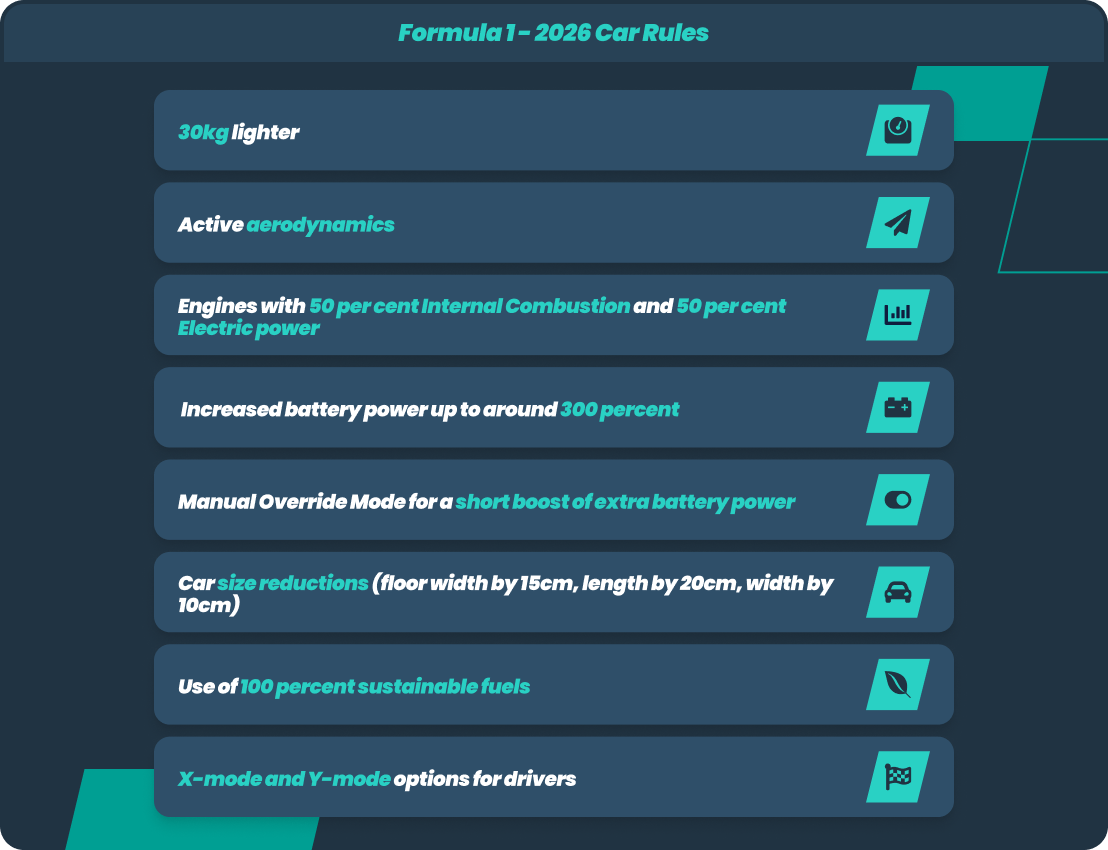
ThePuntersPage Final Say
Speed is king when it comes to F1 gambling. You can keep track of practice sessions, qualifying results, and team news during a Grand Prix with numerous bookmakers.
There are plenty of betting opportunities over three days of racing, when the drama and excitement of driver skills and rivalry heats up. There is also the chance to engage in the entire season with long-term wagers on the Formula One world championships, when it is advisable to utilise some strategic F1 betting tips.
Formula 1 Betting FAQs
Most UK bookmakers carry a comprehensive selection of Formula One betting options and competitive odds, with bet365, BetVictor, and Parimatch among the best for F1 Grand Prix betting.
With UK bookies unable to livestream F1, you can watch the action from Grands Prix with Sky Sports’ dedicated Sky Sport F1 channel.
You can bet on F1 at the majority of UK online sportsbooks, who carry extensive betting markets throughout the Formula One season.
There are a record-breaking 24 races being contested during the 2024 Formula One season.
The 2024 Formula 1 season started with the Bahrain GP in March and will close with the Abu Dhabi GP in December.
The Abu Dhabi Grand Prix is the last race for the 2024 Formula 1 season, taking place on 8 December.
Formula 1 teams, comprising two drivers, contest the Constructors’ Championship each year. There is also an annual Drivers’ Championship.
Formula One Grands Prix are held across five continents and attract a global fanbase. F1 is most popular in Asia, Europe, and South America, with huge interest rapidly developing in North America.






